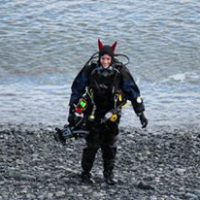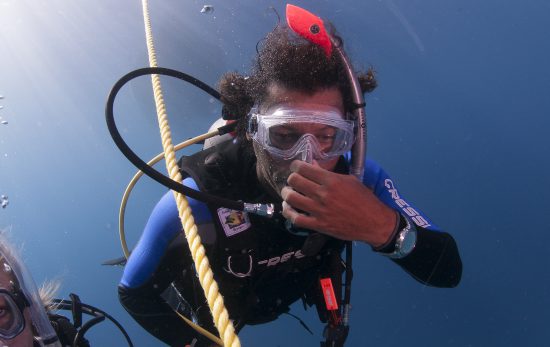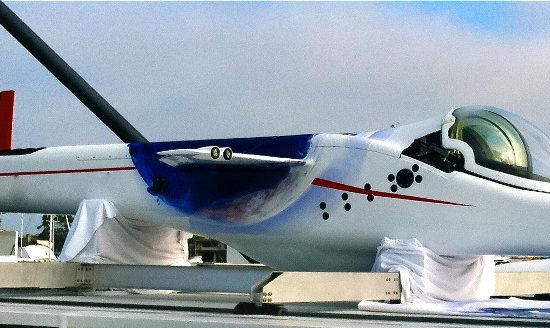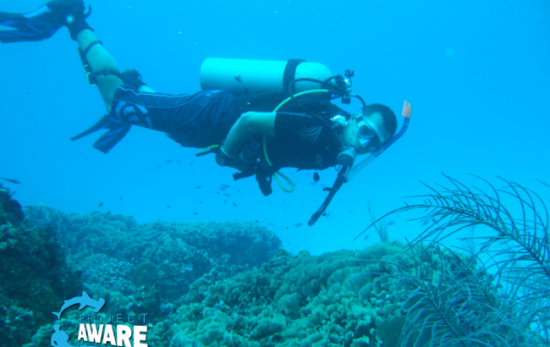This is a start of a series of articles about a TecRec Expedition in South Africa where a team of TecRec Divers are looking for a submarine and a pre-historic fish. The article series starts with a blog by Jonas Samuelsson, PADI Regional Manager and TecRec Instructor Trainer, about what technical diving means for him. Then Patrick Voorma, TecRec Instructor Trainer, describes the objectives of the South Africa Expedition during May month. We hope by our series of articles we can inspire others to explore the wonders of this world.
What does technical diving mean for you?
During a flight from United States to Europe last year I started to talk to the passenger sitting next to me. I explained that I just been diving some caves in Mexico. Hearing this he asked me what technical diving was and why I thought it was so interesting. I gave a pretty conventional answer, but later during the same flight I was thinking about the question further.
What does technical diving really mean for me and why does it fascinate me so much?
The definition of technical diving is pretty straight forward. It is defined simply as a diver who enter an overhead environment like a caves or a wreck. It is when you are diving with mixed gases and can not go straight up to the surface due to decompression obligations. That’s the basic idea of it at least. But is that really the definition of technical diving? Perhaps so in technical terms. For me however its stands for so much more. Technical diving for me is more about the possibilities the equipment and training offer. To be able to explore a world beyond most.
 For me there always been a pararell between space and underwater explorations. Lot of the technical challenges space explorers face is also faced by a technical diver. We are both entering in an environment different than the one that we evolved into living in. Only 12 people have ever walked on the moon but even less have ever dived deeper than 300 meters. To enter these worlds takes years of planning and would not be possible without an abundance of complex life supporting equipment. Is it a part of being human to explore and try to push the established boundaries.
For me there always been a pararell between space and underwater explorations. Lot of the technical challenges space explorers face is also faced by a technical diver. We are both entering in an environment different than the one that we evolved into living in. Only 12 people have ever walked on the moon but even less have ever dived deeper than 300 meters. To enter these worlds takes years of planning and would not be possible without an abundance of complex life supporting equipment. Is it a part of being human to explore and try to push the established boundaries.
But is there any value of “just walking on the moon” or “just diving deep” you might ask yourself. For me it is because the process of doing so, we discover as much about our self as we are developing techniques useful not only in our own field, but in other fields as well. Perhaps a greater understanding how gases effects the human body in extreme environments and the development of rebreather technology used by divers might one day assist the first human’s habitat other planets. But space and underwater explorers have so much more in common than purely the technical. Both groups of explorers share an idea, a philosophy. Inherent for all exploration of all types is the opportunities that it opens up to the people doing the exploring. For some it is the opportunity to gain new knowledge. For others it is the opportunity to create wealth and expand commerce. For still others the opportunity lies in grow spiritually and to gain a greater appreciation of the secrets among us. I
It could be said that by not continuing to explore we face the risk of killing the spirit of adventure and by doing so something fundamental within us would also die. Exploration is what inspire us to greater things and to move mankind forward. It gives us hope and meaning. The environmental movement started with pictures taken of our blue planet from space by the first space explorers. First then did we realize how fragile our planet is and why it is so important to act now to prevent us from destroying all the beauty that took millions if not billions of years to evolve. My hope is that our pictures and videos from the depth of the oceans and lakes would inspire people in the same way as those pictures taken from space.
 Marcel Proust said “the true voyage of discovery is not so much about finding new landscape as to get a new pair of eyes”. The ocean takes up more than 75% of our planet. The ocean got an average depth of 2000 miles and is home of a larger biodiversity and bio density than the rain forest. The ocean has more earthquakes and volcanoes than on land. You find the longest mountain range in the ocean. Most animals live here, and it is mostly unexplored. For example during our expedition in Iceland in June 2011 we dived and filmed geothermal chimneys. Those chimneys was discovered first in 1989 and many believe that it was in chimneys like those in Iceland where life began. Life around those chimneys survives through chemo syntesis rather than photosynthesis which means that all the life supporting energy is coming from the inside of the earth rather than the sun.
Marcel Proust said “the true voyage of discovery is not so much about finding new landscape as to get a new pair of eyes”. The ocean takes up more than 75% of our planet. The ocean got an average depth of 2000 miles and is home of a larger biodiversity and bio density than the rain forest. The ocean has more earthquakes and volcanoes than on land. You find the longest mountain range in the ocean. Most animals live here, and it is mostly unexplored. For example during our expedition in Iceland in June 2011 we dived and filmed geothermal chimneys. Those chimneys was discovered first in 1989 and many believe that it was in chimneys like those in Iceland where life began. Life around those chimneys survives through chemo syntesis rather than photosynthesis which means that all the life supporting energy is coming from the inside of the earth rather than the sun.
Our hope is that our images from places like the chimneys on Iceland would give people those new eyes that Marcel Proust referred to. And with those new eyes have a better understanding how unique and fragile the underwater landscape is. By seeing all the wonders and beauty that lies beneath perhaps we also would also realize that benefit of protecting it. I remember as a little boy sitting by the lake close to the house where I grew up. I looked down, and I was wondering, what was down there. I wanted to explore it. Today, as a technical diving instructor, I am able to explore wrecks, caves, reefs together with some amazing people while traveling around the world and for me that is one of the things that makes life worth living.
Exploration gives us hope that the future can be better, for us and for future generations. Technical diving gives you the tools to do just that….
SUBMARINES AND COELACANTHS Expedition 14 to 23 MAY 2015
 Durban’s Ghost Fleet In 1685 the sailing ship The Good Hope ran aground off the Bluff, South Africa and became the first recorded wreck of the Durban bay. There are 141 recorded wrecks off Durban and many more unrecorded. In the past two years we have been exploring the coastline around Durban in search of some of these wrecks. The first wreck we found was the Namaqua or uMZimvubu as she was best known as. She sunk in 1932. She is at 60 meters approx. 6km NEE of the Durban Harbour.
Durban’s Ghost Fleet In 1685 the sailing ship The Good Hope ran aground off the Bluff, South Africa and became the first recorded wreck of the Durban bay. There are 141 recorded wrecks off Durban and many more unrecorded. In the past two years we have been exploring the coastline around Durban in search of some of these wrecks. The first wreck we found was the Namaqua or uMZimvubu as she was best known as. She sunk in 1932. She is at 60 meters approx. 6km NEE of the Durban Harbour.
The next wreck was the Sir Gordon, the dredger attributed to building the Durban Harbour. She lies in 65m Our most exciting find was that of the HMS Otus, a British Odin class submarine, scuttled in 1946. She is at 105 meters. On the 24 January 2014, 30 years after she sank we found the MV Cape Columbine, a fishing trawler that sprung a leak and sank in 65m. The next exciting discovery was the US Nahma, one of the most expensive private ships built in 1898. She sunk in 1933 and lies in 75m. The last wreck we discovered is at 75m but I am yet to identify her. We have called it Durban’s Ghost Fleet. During my searching for these wrecks I have come across a couple of stories about two possible submarines that were sunk off Durban amidst much secrecy.
 Amongst others, I have spoken to a navy and later commercial diver, who says that he had personal knowledge of these two submarines. He provided me with the approximate depths and positions that he could remember using Durban landmarks. They had no GPS at that time. For the past two years I have been searching this area and am now confident that I have found the position of one of these submarines. She lies at 80 meters.
Amongst others, I have spoken to a navy and later commercial diver, who says that he had personal knowledge of these two submarines. He provided me with the approximate depths and positions that he could remember using Durban landmarks. They had no GPS at that time. For the past two years I have been searching this area and am now confident that I have found the position of one of these submarines. She lies at 80 meters.
I have been fortunate enough to have dived with the late Peter Timm on numerous occasions. Peter discovered the prehistoric fish, the Coelacanth, thought to have been extinct for more than 30 million years in Sodwana’s Jesser Canyon. He has identified more than 19 individual fish before his untimely passing. Peter was confident that if we were to find a similar canyon off Durban on the 100m Isobaths we would find Coelacanths.
 After many hours of searching out at sea using sonar, I have managed to find such a canyon off Durban. So this now all sets the scene for our planned Submarine and Coelacanth expedition in May 2015.
After many hours of searching out at sea using sonar, I have managed to find such a canyon off Durban. So this now all sets the scene for our planned Submarine and Coelacanth expedition in May 2015.
- 14 May: Assemble gear, briefings, final coordination of plans and teams
- 15 May: Check out and shake down dive Max depth 30m.
- 16 May: 60m Dive, procedures, support divers and emergency plans
- 17 May: Discover a Submarine 80m
- 18 May: Revisit the Submarine 80m
- 19 May: HMS Otus Submarine 105m
- 20 May: Canyon Dive searching for Coelacanths 120m
- 21 May: Canyon Dive searching for Coelacanths 120m
- 22 May: Canyon Dive searching for Coelacanths 120m
- 23 May: Canyon Dive searching for Coelacanths 120m
Roger Horrocks will be the cameraman to film this expedition. He has been involved with many underwater documentaries for National Geographic, Discovery, BBC and Disney Channel. He will be filming using the Red Dragon Camera and Gates housing. The team members involved in this expedition will be the following:
- Jonas Samuelsson: PADI Course Director, Tec Trimix Instructor Trainer
- Patrick Voorma: PADI Course Director, Tec Trimix Instructor Trainer
- Allan Maclean: PADI Dive Master, Tec Trimix Diver
- Karl Kruger: PADI Master Instructor, Tec Trimix Diver
- Erik Brown: Tec Trimix Instructor
- Roger Horrocks, Cameraman, Tec Trimix Diver
Expedition South Africa. Objective: Locate, identify and film a Coelacanth.
 The primitive-looking coelacanth was thought to have gone extinct with the dinosaurs 65 million years ago. Coelacanths are elusive, deep-sea creatures, living in depths up to 700 meters. They can be huge 2 meters or more and weighing 90 kilograms. Scientists estimate they can live up to 60 years or more. Their population numbers are, predictably, not well known, but studies in the Comoros suggest only about 1,000 remain there. They are considered an endangered species.
The primitive-looking coelacanth was thought to have gone extinct with the dinosaurs 65 million years ago. Coelacanths are elusive, deep-sea creatures, living in depths up to 700 meters. They can be huge 2 meters or more and weighing 90 kilograms. Scientists estimate they can live up to 60 years or more. Their population numbers are, predictably, not well known, but studies in the Comoros suggest only about 1,000 remain there. They are considered an endangered species.
Read the PADI TecRec Blog of our story
Here are some links to the wrecks we have found so far:




